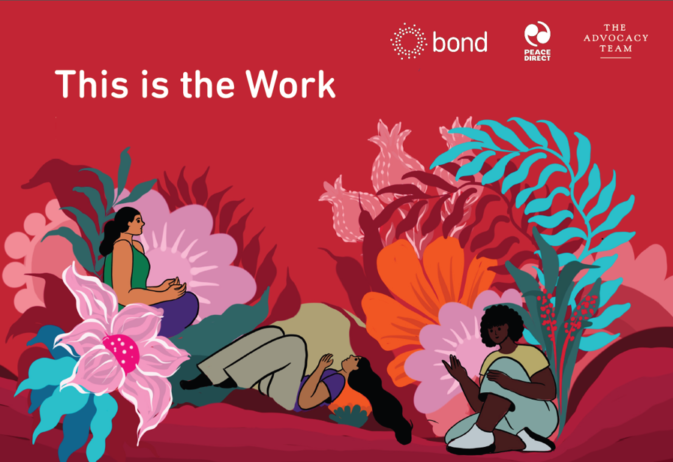A guide to becoming locally led
Bond, along with the Social Investment Consultancy (TSIC) and its three Bond working groups: Practice for locally led development; Sector commitments and Roadmap for locally led development; Changing donor policy and practice for locally led development has launched its guide for international non-profits and development organisations – Becoming locally led as an anti-racist practice: a guide.
The guide, which will evolve as it is used, has been developed in response to growing demand from the international development sector to change how organisations work, make decisions, and are structured and governed, with the aim of becoming more locally led.
Who is ‘Becoming locally led as an anti-racist practice: a guide’ for?
The guide is for international organisations of varying sizes based in higher-income countries, such as the UK, which work in partnership with colleagues from around the world and want to shift their practices and use of power to become more locally led.
Anyone in an organisation who wants to, or already is, driving change can use this guide, from those in leadership positions to more junior roles. Whether you work in Human Resources, Finance, Fundraising, Administration, Programming, Monitoring and Learning, Communications or are a Trustee the report is directly relevant to your role. We are all part of an ecosystem.
How was the guide developed?
The guide has been developed by the Social Investment Consultancy (TSIC), and was supported by a steering group consisting of members from three Bond working groups, each of which focuses on a different aspect of locally led development (sector commitments, practice and donors).
Across these working groups we discussed how important it is to avoid replicating existing efforts and ensure that the work we do collectively strengthens and supports organisations, with a specific focus on the actions which INGOs need to take to become locally led.
Those of us within the INGO sector exist in a constantly evolving ecosystem, with a responsibility to adapt our ways of working as we learn and grow. All of us – including donors and sub-contracting organisations – have a role to play, no matter our organisation’s size, geographical location, thematic focus or approach, be it humanitarian, peacebuilding or development.
Becoming locally led as an anti-racist practice: a guide
Download the guideOne of the questions we discussed whilst developing this guide to becoming locally led, is why, until recently, we have failed to hold ourselves accountable to our counterparts and their communities in the same way as we are accountable to charity regulators? Could it be because the charity commission could cease our existence, and we don’t consider communities to have the power or leverage to do so? The current model isn’t equitable, and things need to change if we really are committed to building a more just world.
Third Sector Magazine recently published an article on the impact laborious grant application processes have on small and medium sized organisations, which concluded that the system “should ideally be designed to contribute to achieving impact, effectiveness and value for money. However, there is no evidence that this is the case.” This has got to stop.
Feeling the fear and doing it anyway
There are lots of pledges and movements across the sector trying to drive forward change. Bond’s working group on sector commitments conducted a mapping exercise and engaged with stakeholders, and found plenty of evidence of this. Undoubtedly, in some brave spaces the energy is there. But where is the widespread commitment and willingness to engage in a transformation process that may exclude INGOs from positions of power?
We need to move beyond performative intention and measures to actively embrace the fluidity that becoming truly locally led brings, despite not knowing what it means for INGOs.
This guide brings together learnings from the three working groups to provide a baseline consensus on what locally led development should look like. Different organisations will engage with the guide from different starting points, with some having already taken significant steps and others ready to start from the beginning.
No matter where an organisation is in its journey, the guide will give it the tools to review its current ways of working and to identify where each of its departments is on the road to locally led development. The guide outlines how teams can overcome differences and engage in discussions to achieve an aligned understanding, mapping out the next coordinates in the organisation’s journey to becoming truly locally led.
Piloting the guide: become a locally led organisation
Now that we have launched the guide, we’re looking for organisations to volunteer and join with their peers in piloting it. By doing so, together we can set sail and navigate these unsure seas, ones that we’ve talked about sailing on for years.
If this sound like something your organisation may be interested in, please get in touch with Yolaina Vargas Pritchard, Sector change and funding adviser: [email protected].
Above all, we must remember it is not the responsibility of our counterparts in middle- and low-income countries to drive change. This is our problem, and we need to fix it. It might not be a graceful process, it might not be refined, and it must rightly lead to a shift in power, but we now have a place to start. From here, collectively, we can learn – and move towards an equitable and just global development system for all.
For more on this topic, try the following blogs.
- Locally led development: Ready to set sail… but on rough seas
- Locally led development: What does this mean in practice?
- Locally led development starts with how we transform ourselves
- Why locally led development must be at the heart of the new International Development Strategy
- Are country offices preventing us from decolonialising development?
This blog was written by Clare Nolan and Neelam Dave of SOS Children’s Villages UK.
Category
News & Views


